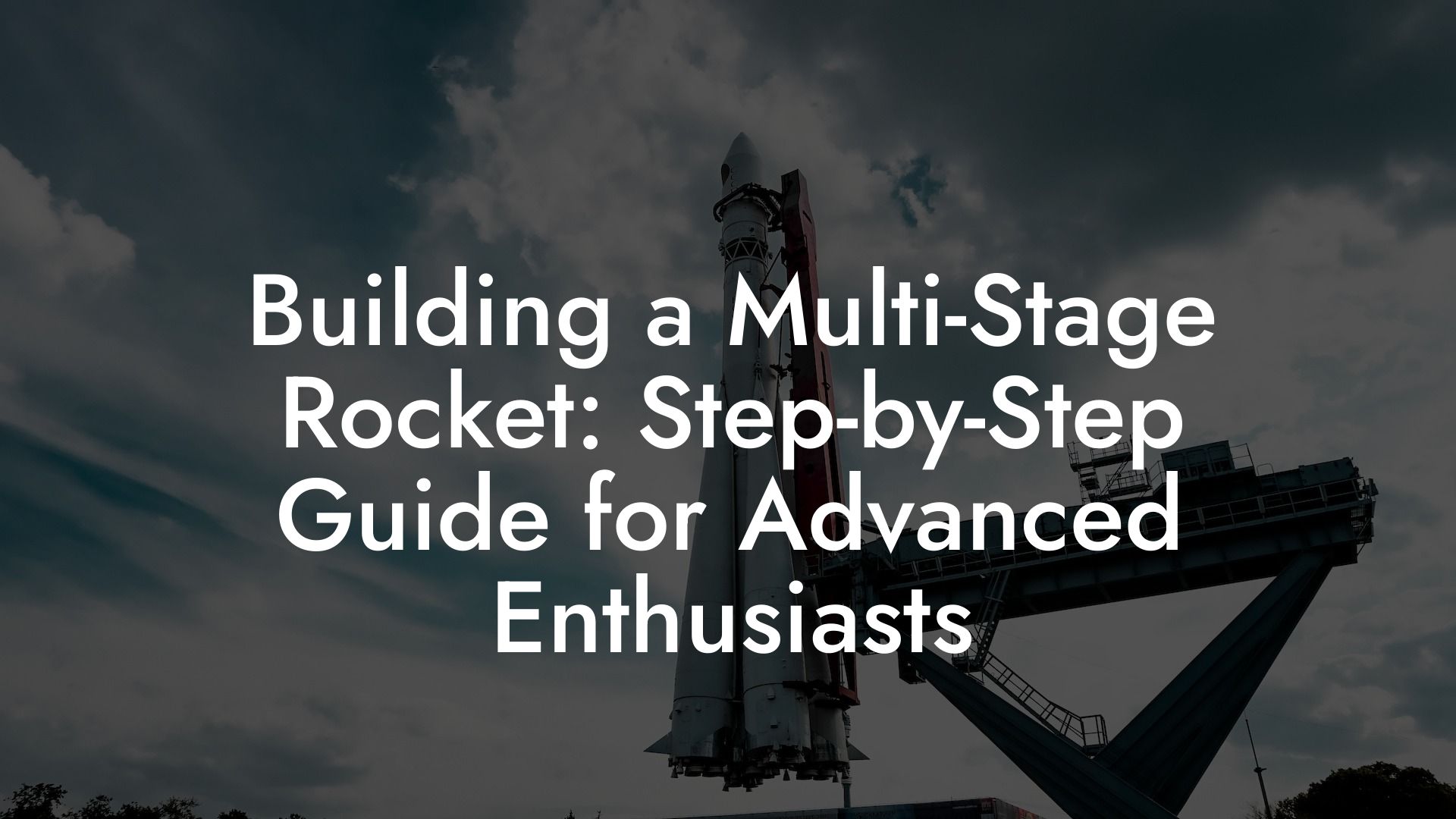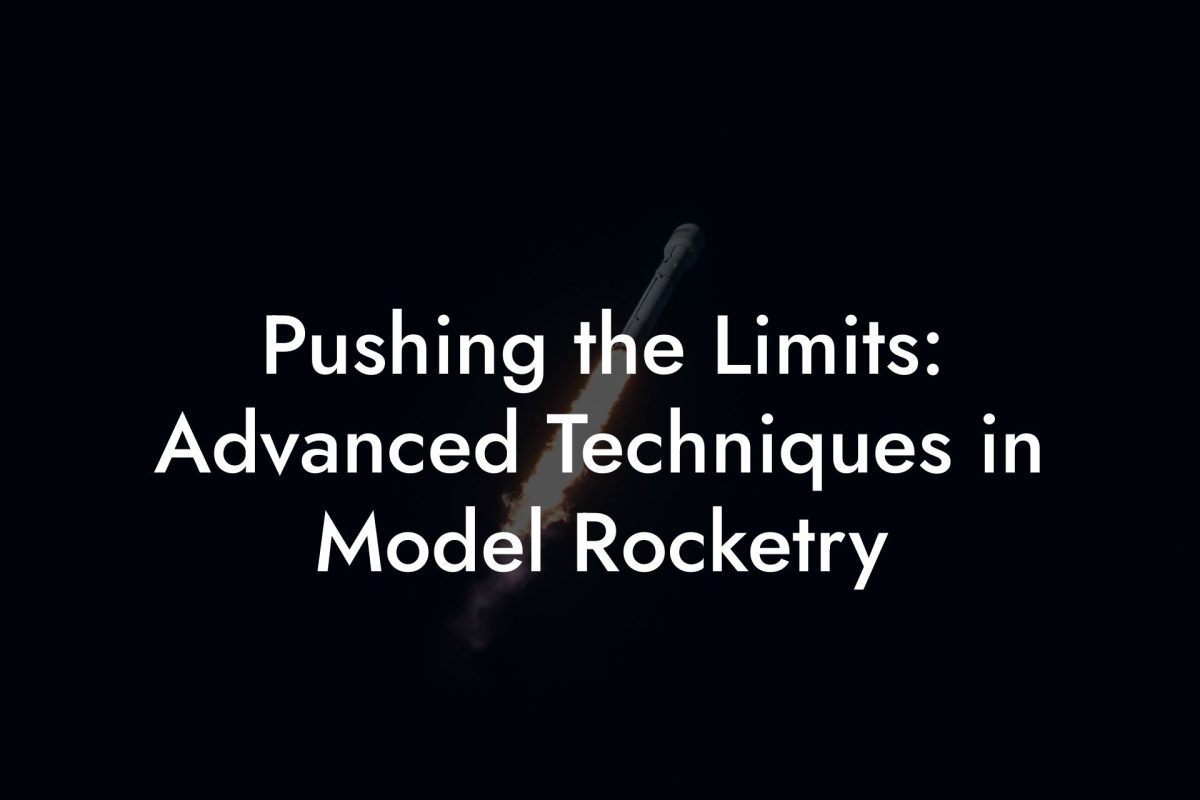For advanced rocketeers looking to push the boundaries of flight, building a multi-stage rocket is the ultimate challenge and reward. In "Building a Multi-Stage Rocket: Step-by-Step Guide for Advanced Enthusiasts," we break down every aspect of designing, constructing, and launching a multi-stage rocket. This comprehensive guide covers everything from conceptual design and material selection to stage integration, recovery planning, and post-launch analysis. Prepare to take your model rocketry skills to new heights as you master the art and science of multi-stage rocket construction.
Quick Links to Useful Sections
- Introduction: The Art and Science of Multi-Stage Rocketry
- Understanding Multi-Stage Rocketry
- Planning and Design: From Concept to Blueprint
- Defining Your Objectives
- Sketching and Conceptualization
- Digital Modeling and Simulation
- Materials and Tools: Equipping Your Workshop
- Selecting the Right Materials
- Essential Tools and Equipment
- Stage-by-Stage Assembly: Building Your Multi-Stage Rocket
- Stage 1: The Booster Stage
- Stage 2: The Sustainer Stage
- Stage 3: The Payload Stage (Optional)
- Stage Integration and Separation
- Separation Mechanisms
- Testing and Iteration: From Prototype to Final Build
- Component Testing
- Full-System Test Launches
- Maintenance and Pre-Launch Checks
- Model Rocketry FAQs: Multi-Stage Rockets
- Your Next Launch: Push the Limits and Soar Higher
Introduction: The Art and Science of Multi-Stage Rocketry
Multi-stage rockets represent the pinnacle of model rocketry, combining multiple propulsion phases to achieve higher altitudes and longer flights than single-stage rockets can offer. By shedding excess weight during flight, a well-designed multi-stage rocket can maintain acceleration and efficiency throughout its ascent. This guide is designed for advanced enthusiasts who are ready to tackle the complex engineering, precise construction, and meticulous planning required to build a multi-stage rocket.
In the following sections, we will walk you through the entire process, from the initial design phase to final launch and recovery. Whether you are optimizing your fuel efficiency, refining aerodynamic performance, or integrating advanced digital telemetry, every step in building a multi-stage rocket is an opportunity to innovate and push the limits of your rocketry expertise.
Understanding Multi-Stage Rocketry
Multi-stage rockets consist of two or more separate stages, each equipped with its own propulsion system. The fundamental principle behind multi-stage design is to discard spent stages during flight, reducing the overall mass and allowing the remaining stages to accelerate more efficiently. This approach not only increases the rocket’s altitude but also enhances its stability and flight duration.
Key benefits of multi-stage rockets include:
Looking For The Best Model Rocket Kits? You'll Love These:
- Increased Altitude: By shedding weight, multi-stage rockets can reach significantly higher altitudes.
- Improved Efficiency: Each stage operates at optimal performance, maximizing thrust-to-weight ratios.
- Enhanced Control: Sequential staging allows for tailored control during different phases of flight, from liftoff to payload deployment.
- Versatility: Multi-stage designs offer flexibility in payload integration and recovery strategies.
However, building a multi-stage rocket also introduces complexities such as stage separation, inter-stage communication, and intricate recovery systems. This guide will address these challenges head-on.
Planning and Design: From Concept to Blueprint
The success of your multi-stage rocket begins with a well-thought-out design. Advanced planning is crucial to ensure that each stage functions seamlessly with the others.
Defining Your Objectives
Start by clarifying your mission objectives. Are you aiming for maximum altitude, long-duration flight, or a specific payload deployment? Your goals will influence the design parameters for each stage, including engine type, fuel requirements, and recovery strategy.
Sketching and Conceptualization
With your objectives in mind, sketch out your rocket’s overall design. Consider the following aspects:
- Stage Configuration: Decide on the number of stages and their respective functions (e.g., booster stage, sustainer stage, payload stage).
- Separation Mechanisms: Plan for how and when each stage will separate. This may involve mechanical latches, pyrotechnic devices, or pneumatic systems.
- Structural Integration: Ensure that the stages are designed to connect securely while allowing for efficient separation and minimal interference during flight.
Digital Modeling and Simulation
Use CAD software such as Fusion 360, SolidWorks, or SketchUp to create detailed 3D models of your rocket. Integrate simulation tools like Computational Fluid Dynamics (CFD) to analyze airflow and aerodynamic stability, and finite element analysis (FEA) to evaluate structural integrity. These digital tools will help you identify potential issues before you start building.
A detailed blueprint, complete with measurements, material specifications, and staging sequences, is the foundation for a successful build.
Materials and Tools: Equipping Your Workshop
Advanced multi-stage rocketry demands high-quality materials and precision tools to achieve the necessary performance and durability.
Selecting the Right Materials
For each stage of your rocket, consider using advanced materials that offer the best balance of strength, weight, and cost:
- Body Tubes and Structural Components: Consider using carbon fiber, fiberglass, or reinforced composite materials for a lightweight yet robust structure.
- Fins: Use precision-cut materials such as balsa wood for prototypes or carbon fiber for high-performance applications, ensuring smooth surfaces and optimal aerodynamic profiles.
- Engine Casings: Durable plastics or composites that can withstand high temperatures and pressures during combustion.
- Adhesives: High-strength epoxies and specialized aerospace-grade adhesives are essential for reliable bonding between components.
Essential Tools and Equipment
Advanced projects require precision tools. Equip your workshop with:
- Precision Cutting Tools: Laser cutters, fine craft knives, and precision saws for accurate component shaping.
- Measuring Instruments: Digital calipers, micrometers, and laser measuring devices for exact measurements.
- CAD and Simulation Software: For designing and testing your rocket virtually.
- Assembly Tools: Clamps, jigs, and specialized fasteners to hold components in place during curing and testing.
With the right materials and tools, your workshop becomes a hub for innovation and precision, setting the stage for a flawless build.
Stage-by-Stage Assembly: Building Your Multi-Stage Rocket
The assembly of a multi-stage rocket is a complex, multi-phase process. Each stage must be built individually with precision and then integrated seamlessly into the overall design.
Stage 1: The Booster Stage
The booster stage is responsible for the initial thrust during liftoff. Its design must prioritize maximum thrust and durability to overcome the gravitational pull.
- Engine Mount: Securely attach a high-thrust engine designed for rapid acceleration.
- Structural Integrity: Reinforce the body tube with composite materials to withstand intense vibrations and pressures.
- Separation Mechanism: Integrate a reliable stage separation system that will eject the booster stage at the optimal time.
Focus on ensuring that the booster stage delivers a powerful, consistent burn and that its separation mechanism works flawlessly.
Stage 2: The Sustainer Stage
Following booster separation, the sustainer stage takes over to continue the rocket’s ascent. This stage is typically lighter and designed for longer burn times.
- Engine and Fuel Optimization: Select an engine with a longer burn time and moderate thrust, suitable for the thinner air at higher altitudes.
- Structural Considerations: Use lightweight materials to minimize mass while maintaining strength.
- Seamless Integration: Ensure that the sustainer stage’s interface with the booster stage is designed for smooth separation and minimal aerodynamic disruption.
The sustainer stage should carry the rocket smoothly into the upper atmosphere, maintaining stability and optimizing the overall flight trajectory.
Stage 3: The Payload Stage (Optional)
For those looking to add extra functionality, a payload stage can be integrated. This stage can carry sensors, cameras, or other experimental equipment.
- Lightweight Design: Use ultra-light materials to ensure that the payload does not significantly affect the rocket’s performance.
- Secure Integration: Ensure that the payload is securely attached and that its weight is balanced to maintain the rocket’s center of gravity.
- Recovery Considerations: Design the payload stage to withstand the recovery process, with shock-absorbing mounts if necessary.
While optional, the payload stage adds versatility to your rocket and opens up possibilities for experiments and data collection.
Stage Integration and Separation
One of the most critical aspects of multi-stage rocketry is ensuring that each stage separates cleanly and at the right moment. The integration of stages involves both mechanical design and precise timing.
Separation Mechanisms
Common separation methods include:
- Pyrotechnic Ejection Charges: Small explosive charges that forcefully eject a stage after burn-out.
- Mechanical Latches: Devices that release stages through a mechanical trigger, often synchronized with engine burnout.
- Pneumatic Systems: Utilizing compressed air to push stages apart, offering controlled and gentle separations.
Testing and fine-tuning these mechanisms are paramount. Each stage must detach cleanly without disturbing the flight path of the remaining rocket.
Testing and Iteration: From Prototype to Final Build
Building a multi-stage rocket is an iterative process. Each stage should be thoroughly tested in isolation before integration, and the full assembly should be test-launched to validate performance.
Component Testing
Begin with ground tests:
- Test each stage’s engine performance and burn time.
- Verify the integrity of structural components under simulated launch stresses.
- Conduct separation tests to ensure reliable stage ejection.
Full-System Test Launches
Once individual components pass their tests, integrate the stages and perform full-system launches. Collect telemetry data and high-speed video to analyze flight dynamics, stage separation, and recovery performance.
Use this data to refine designs and make iterative improvements. Every test launch is a valuable learning experience that brings you closer to a reliable, high-performing rocket.
Maintenance and Pre-Launch Checks
Regular maintenance is critical, especially for a multi-stage rocket with complex interfaces and separation mechanisms. After each launch, inspect every stage for wear, adhesive integrity, and proper function of separation systems.
A detailed pre-launch checklist should include:
- Visual inspection of all stages for structural integrity.
- Function testing of separation mechanisms and ejection charges.
- Verification of engine mounting and alignment.
- Check of payload security and sensor calibration (if applicable).
Consistent maintenance ensures that your rocket is always ready for the next launch and reduces the risk of in-flight malfunctions.
Model Rocketry FAQs: Multi-Stage Rockets
Here are some frequently asked questions to help advanced enthusiasts tackle the challenges of multi-stage rocketry:
1. What are the main advantages of multi-stage rockets?
Multi-stage rockets achieve higher altitudes and improved efficiency by shedding excess weight during flight, which allows the remaining stages to accelerate more effectively.
2. How do I determine the optimal number of stages for my rocket?
The optimal number of stages depends on your altitude goals, payload requirements, and design complexity. Simulations and iterative testing can help determine the best configuration.
3. What are common separation mechanisms used in multi-stage rocketry?
Common methods include pyrotechnic ejection charges, mechanical latches, and pneumatic systems. Each method has its own benefits and should be selected based on your specific design needs.
4. How important is stage integration for overall performance?
Stage integration is critical. A clean and well-timed separation ensures that the remaining rocket maintains a stable flight path and optimal performance.
5. What materials are recommended for constructing multi-stage rockets?
Advanced composites like carbon fiber and fiberglass are ideal for reducing weight and increasing structural strength, while high-quality adhesives and precision fasteners ensure secure stage connections.
6. How can I improve the reliability of stage separation?
Thorough testing, precise engineering of separation mechanisms, and the use of reliable ejection charges are key to ensuring clean and timely stage separations.
7. What role does telemetry play in multi-stage launches?
Telemetry provides real-time flight data that can be used to monitor stage performance, verify proper separation, and fine-tune design parameters for future launches.
8. Are there any specific challenges in recovering a multi-stage rocket?
Recovery can be more complex, as each stage may require its own recovery system. Ensuring that all recovery devices deploy correctly is essential for the safe retrieval of each stage.
9. How do I manage weight distribution across multiple stages?
Careful design and iterative testing are necessary to balance weight distribution. Adjusting fuel load, structural materials, and payload placement can help maintain an optimal center of gravity.
10. Can I upgrade individual stages without rebuilding the entire rocket?
Yes, one of the advantages of modular, multi-stage designs is that you can replace or upgrade individual stages, engines, or recovery systems as your technology advances.
Your Next Launch: Push the Limits and Soar Higher
Building a multi-stage rocket is a complex and challenging journey that rewards innovation, precision, and perseverance. With careful planning, advanced design techniques, and iterative testing, you can create a rocket that not only reaches new altitudes but also sets the stage for further exploration in rocketry.
Embrace the challenge, refine your techniques, and let every launch be a stepping stone toward pushing the limits of what’s possible. The sky is just the beginning, it's time to innovate, experiment, and soar higher than ever before.
Looking For The Best Model Rocket Kits? You'll Love These:
Useful Interruption: Dive deeper into the world of Model Rockets with our most popular sections. If there is anything you think is missing or anything you would love for us to write about, just give us a shout.
- Getting Started & Basics With Model Rockets
- Model Rocket Design, Build & Customization
- Model Rocket Propulsion & Engine Technology
- Model Rocket Launch Techniques & Recovery
- Model Rocket Advanced Rocketry & Innovations
- Model Rocket DIY and Customization
- Model Rocket Equipment Reviews & Digital Tools
- Community, Competitions & Education
- Model Rocket Troubleshooting & FAQs
- Model Rocket Bonus/Seasonal & Niche Topics
A group of model rocket enthusiasts gathered at a field for their weekly launch event. Among them was Dave, a seasoned builder known for pushing the limits of hobby rocketry. This time, he had outdone himself.
“Ladies and gentlemen,” Dave announced, dramatically pulling a cloth off his latest creation, “I present to you: The Kraken!”
The crowd gasped. This wasn’t just a model rocket, it was a monster. The thing stood 8 feet tall, had six clustered engines, and was covered in enough duct tape to qualify as a classified aerospace project.
“Dave,” muttered Steve, the cautious safety officer, “Have you, uh… done the math on this?”
“Math?” Dave scoffed. “I built it in my garage at 3 a.m. with parts from eBay. This is an art piece, Steve.”
The countdown began.
5…
4…
3…
2…
1…
The engines ignited with a BOOM, and The Kraken shot up… kind of. It immediately did a violent barrel roll, narrowly missing the spectators before skyrocketing at an angle that could only be described as “legally questionable.”
The crowd collectively ducked as The Kraken flew straight over the adjacent cornfield, where Old Man Jenkins, the grumpiest farmer in town, was minding his business.
KABOOM!
The rocket disappeared behind the barn. A moment later, a flaming piece of Estes igniter wire landed at Steve’s feet. The silence was deafening.
And then, an unmistakable sound echoed across the field.
Jenkins’ shotgun being cocked.
“DAVE!!!” Steve shouted. “RUN.”
And that was the day Dave invented the first-ever biologically powered rocket booster: pure adrenaline.
To this day, nobody knows where The Kraken landed, but legend has it, it still haunts the skies, terrifying unsuspecting drones and low-flying birds.






